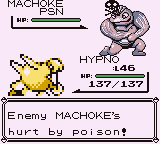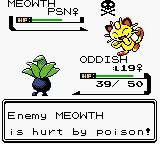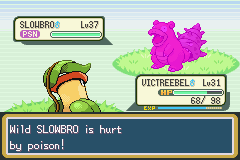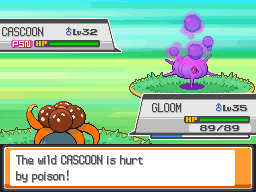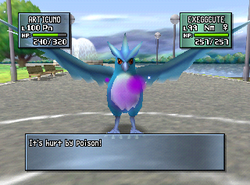Poison (status condition): Difference between revisions
TheHateHat (talk | contribs) |
|||
| Line 180: | Line 180: | ||
===Other causes=== | ===Other causes=== | ||
{{a|Poison Point}} has a 30% chance of poisoning the opponent when contact is made with the user, {{a|Poison Touch}} has a 20% chance of poisoning the target when the user uses a contact move, {{a|Effect Spore}} has a 10% chance of poisoning the target when the user uses a contact move. A Pokémon can also be poisoned if it directly poisons a Pokémon with {{a|Synchronize}}. | {{a|Poison Point}} has a 30% chance of poisoning the opponent when contact is made with the user, {{a|Poison Touch}} has a {{tt|30|20 in the Japanese versions of Black and White}}% chance of poisoning the target when the user uses a contact move, {{a|Effect Spore}} has a 10% chance of poisoning the target when the user uses a contact move. A Pokémon can also be poisoned if it directly poisons a Pokémon with {{a|Synchronize}}. | ||
===Moves that badly poison=== | ===Moves that badly poison=== | ||
Revision as of 02:28, 10 December 2012

The poison condition (PSN) (Japanese: どく Poison) is a non-volatile status ailment found in the Pokémon games, it causes a Pokémon to lose HP at the end of every turn, as well as outside of battle prior to Generation V. It can be caused by several moves most of which are Poison-type, and some Abilities. Poison and Steel-type Pokémon are immune to being poisoned, making it the only non-volatile status ailment to be ineffective against more than one type; however, in Generation II, Steel-type Pokémon can be poisoned by Twineedle.

Along with the poison status, a Pokémon can also be badly poisoned; the effects are similar to poison but instead of having a set amount of damage dealt each turn, badly poisoned Pokémon will receive increasing amounts of damage each turn.
Effect
The effects of poison vary between generations, but a poisoned Pokémon will lose HP at the end of every turn. Until Generation V, a poisoned Pokémon will lose one HP for every four steps taken outside of battle.
Generation I
A poisoned Pokémon will lose 1/16 of its maximum hit points every turn in battle. Outside of battle, a poisoned Pokémon will lose one HP for every four steps taken. If a poisoned Pokémon causes an opponent to faint, it will not take damage that turn. A badly poisoned Pokémon will lose 1/16 of its maximum HP on the first turn, after which damage will increase by 1/16 every time damage is dealt to the badly poisoned Pokémon. Switching a badly poisoned Pokémon out or a battle ending will turn the badly poisoned status into normal poison. A badly poisoned Pokémon that is also under the effect of Leech Seed will have its poison damage counter, as well as its Leech Seed damage, increase by 1/8 and 1/16 of the Pokémon's maximum HP each turn respectively. Haze will bring the damage taken by badly poisoned Pokémon back to 1/16. Rest will remove the bad poison, but will not reset the damage counter. If a Pokémon gets badly poisoned again, its damage taken will carry on from where it was when using Rest.
Generation II
In-battle damage taken by a poisoned Pokémon was increased to 1/8 of the Pokémon's maximum HP. Bad poisoning remains at a starting amount of 1/16, but now increases in damage at the end of every turn, and can no longer increase the damage taken from Leech Seed. Haze no longer affects poisoning. While Steel-type Pokémon cannot be poisoned by Poison-type moves, they can still be poisoned by Twineedle.
Generation III
If a badly poisoned Pokémon is switched out, it will keep the badly poisoned status; however, the damage counter will reset. From this generation onward, a poisoned Pokémon will take damage even if it knocks out an opponent. Ending a battle will still change the badly poisoned status to normal poison, normal poison remained unchanged. Steel-type Pokémon cannot be poisoned by Twineedle.
Generation IV
Same as before, but if a poisoned Pokémon is brought down to one HP due to poison damage outside of battle, its poison status will be cured instead of the Pokémon fainting, as in previous generations.
Generation V
A poisoned Pokémon no longer receives damage outside of battle, and a poisoned Pokémon now glows purple in battle. The poison status will cause a Pokémon to take double damage from Hex and Venoshock. Switching a Pokémon out no longer changes the status to normal poison. Bad poison has dark purple characters instead of white.
Appearance
Causes
Moves
The following moves may poison the target:
|
Other causes
Poison Point has a 30% chance of poisoning the opponent when contact is made with the user, Poison Touch has a 30% chance of poisoning the target when the user uses a contact move, Effect Spore has a 10% chance of poisoning the target when the user uses a contact move. A Pokémon can also be poisoned if it directly poisons a Pokémon with Synchronize.
Moves that badly poison
The following moves may badly poison the target:
|
Other causes
The item Toxic Orb badly poisons the holder at the end of the turn. A Pokémon can also be badly poisoned if it directly badly poisons a Pokémon with Synchronize*.
Poisoning Steel and Poison-type Pokémon
Although difficult, it is possible for Steel and Poison-type Pokémon to be poisoned. In Generation II, the move Twineedle could poison Steel-type Pokémon; however, this was removed in future Generations. A Poison or Steel-type Pokémon can be poisoned if its type is changed through a move like Soak, is then poisoned and switched out. When the Pokémon is sent out again, the poison status will remain even though the Pokémon's type has changed back to Poison or Steel. Also, poisoned Pokémon who evolve into a Poison- or Steel-type Pokémon, such as Cascoon evolving into Dustox, will keep the poisoned status after evolving.
Prevention and curing
Whether a Pokémon is poisoned or badly poisoned, prevention and curing remain unchanged. Items and Berries that solely cure poisoning include Antidote, PSNCureBerry (Generation II only), Drash Berry (Generation III only) and Pecha Berry. Items and Berries that cure poison as well as other status ailments include Full Heal, Lava Cookie, Full Restore, Old Gateau, Heal Powder, Lum Berry, MiracleBerry (Generation II only), Casteliacone, and Sacred Ash. Moves can also be used to prevent or cure poisoning; Safeguard will prevent the user's team from being afflicted by any status ailment for five turns and a Pokémon behind a substitute cannot be poisoned (other than holding a Toxic Orb). Moves that can be used to cure poisoning are: Refresh, Rest, Psycho Shift*, Heal Bell and Aromatherapy. Poisoning can be prevented with the Abilities Immunity and Leaf Guard*, and can be cured by Hydration* and Shed Skin*. Natural Cure will cure the user of any status ailment upon switching out, and Healer has a 30% chance of healing allies of status ailments in Double Battles and Triple Battles. The Ability Magic Guard will prevent damage due to poison from being taken in battle; however, it does not prevent the damage from being taken outside of battle.
Advantages
While poisoning and badly poisoning, like all major status ailments, have primarily negative effects, it can be advantageous to be poisoned in certain conditions. Pokémon with Guts, Marvel Scale, and Quick Feet will have their Attack, Defense, and Speed increased by 50%, respectively, if poisoned or afflicted by any other non-volatile status ailment excluding sleep and freeze; however, in Generation IV, sleep will increase the Attack of Pokémon with Guts. Poisoning will increase the attack of a Pokémon with Toxic Boost by 50%, and the base power of Facade is doubled (from 70 to 140) when inflicted with poison. A Pokémon with Poison Heal will regain 1/8th of its maximum HP at the end of each turn instead of taking damage. When capturing Pokémon, the poison status also adds a 1.5× multiplier to the catch rate of any given Pokémon.
Other in-game effects
If a poisoned Pokémon gains the Ability Immunity through the use of Skill Swap, Trace or another method, the poison or bad poison status will be removed, but once Immunity is lost, the poison status will be regained, with bad poison keeping its damage counter. In Pokémon Emerald, when the player is inside the Battle Pyramid, the types of Pokémon encountered on each floor follow a set of categories, on the second floor the player will encounter Pokémon that poison as their main tactic. In the Generation IV games, Pokémon Platinum, HeartGold and SoulSilver, at the Battle Arcade, one of the effects caused by the roulette is causing the poison status; Pokémon that would normally be immune to poison are unaffected. The poison will last for a single battle.
In other media
In the side games
Pokémon Mystery Dungeon
Like the main games, Pokémon Mystery Dungeon also features both normal poisoning as well as bad poisoning. When a Pokémon is poisoned, it takes damage every ten turns and is also prevented from regenerating HP. Poison does not disappear over turns. When a Pokémon is badly poisoned, it takes damage every two turns and also prevents regenerating HP. Similar to the main games, the poison conditions do not disappear over turns but can be healed with certain moves or items, and by going to the next floor.
In the anime

The poison status has been shown several times in the anime:
- In Sharpedo Attack!, while Brock is battling a Sharpedo it suddenly faints. He examines it and realizes that it's poisoned from Seviper's Poison Tail. Brock does everything he can for Sharpedo, but they don't have any medicine, and after a while, Sharpedo's poison gets cured.
- In Keeping In Top Forme!, Shaymin, Piplup and Pikachu all get poisoned, Shaymin from getting exposed to some kind of poison and Pikachu and Piplup from a wild Shroomish using PoisonPowder on them. Shaymin is cured by Brock who uses a Pecha Berry on it, and Pikachu and Piplup are cured by Shaymin's Aromatherapy.
- In A Real Rival Rouser! during a battle between Paul and Ash, Paul's Drapion uses Toxic Spikes which poisons every Pokémon Ash sends out (regardless of type), Ash's Buizel, Staraptor, Torterra, Infernape and Gliscor get poisoned from the Toxic Spikes.
- In The Brockster Is In! Ash's Pikachu and all of Normajean's Pokémon get poisoned by wild Tentacruel's Poison Sting and Poison Jab. Brock uses Pecha Berries to cure them. He also has his Chansey to use Softboiled on Normajean's Pichu. In this episode, it seems that a fever and difficulty breathing is a side effect to the poison.
- In A Venipede Stampede!, Ash becomes poisoned when a wild Venipede headbutts him, due to Venipede's Poison Point. He is cured by a remedy that Cilan made.
- In Facing Fear with Eyes Wide Open!, Scraggy's aggressiveness towards a group of Foongus causes the Foongus to use PoisonPowder in retaliation, affecting all of Ash, Iris, and Cilan's Pokémon except for Oshawott, who had been training with his Trainer and Excadrill who was not out. While Iris took care of the sick Pokémon, Ash, Oshawott, and Cilan went to a nearby pond to get Remeyo weed for Iris's poison remedy. After fending off the pond's Tympole, Ash and Cilan capture the Tympole's leader, Palpitoad, and its ally, Stunfisk, respectively, allowing them access to the herbs.
- In The Four Seasons of Sawsbuck!, a Pokémon photographer named Robert becomes poisoned by an Amoonguss's PoisonPowder while trying to save a Deerling from a similar fate. He is cured by the Deerling's Sawsbuck friends with the help of a mysterious lake.
- In Rocking the Virbank Gym! (Part 1) and Rocking the Virbank Gym! (Part 2), Ash's Unfezant, Leavanny, Pignite, Palpitoad, and Pikachu are all poisoned during Ash's Gym battle against Roxie's Poison-type Pokémon. Out of these, Leavanny and Pignite are badly poisoned. Roxie also cures Pignite and Pikachu from poison with Pecha Berries.
In the manga
In the Pokémon Adventures manga
In The Secret of Kangaskhan when Red suspects that there is something wrong with a baby Kangaskhan, he realizes it is poisoned, and uses an Antidote to cure it.
In the TCG
- Main article: Special Conditions

In the Trading Card Game, Poisoned is one of the five Special Conditions along with Asleep, Burned, Confused, and Paralyzed. When a Pokémon is Poisoned, a poison counter is placed on it and one damage counter is put on the Pokémon in between each turn. Some attacks require the player to put two, three, or even four damage counters on a Pokémon between turns, instead of the normal one. The condition can be removed by returning the affected Pokémon to the Bench or by evolving it. Unlike the Pokémon games, a Pokémon can be afflicted with more than one Special Condition at once; however, some Special Conditions will erase ones already present.
| Status conditions | |||
|---|---|---|---|
| BURN | FREEZE | PARALYSIS | POISON |
| SLEEP | CONFUSION | FLINCH | FAINTING |

|
This game mechanic article is part of Project Games, a Bulbapedia project that aims to write comprehensive articles on the Pokémon games. |
